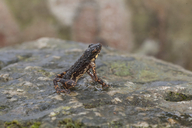|
Ansonia thinthinae Wilkinson, Sellas & Vindum, 2012
Thin Thin's Stream Toad | family: Bufonidae genus: Ansonia |
| Species Description: Wilkinson JA, Sellas AB, Vindum JV 2012 A new species of Ansonia (Anura: Bufonidae) from northern Tanintharyi Division, Myanmar. Zootaxa 3163:54-58. | |
 Jens V. Vindum © 2014 California Academy of Sciences (1 of 8) |
|
|
|
Description Ansonia thinthinae can be distinguished from geographically or genetically close relatives by a number of characters. Males have a snout-vent length of between 22.1 and 29 mm, with the snout-vent length of females at around 31.8 mm. The head of males is wider than it is long in males, with a light patch visible below the eye. Yellow tubercles are present at the corner of the jaw. A. thinthinae has one vocal slit, and spotting on the gular region. The dorsum is tuberculated. The first finger is significantly shorter than the second, with finger tips that are rounded, but do not form disks. In males, both the first and second fingers have nuptial pads. Webbing reaches the disks on toes three and five. The dorsum is brown with a yellow interscapular spot. There is yellow spotting on the venter, which fuses into a larger pattern against a brown background. The iris color is yellow (Wilkinson et al. 2010). Its coloration in preservation is dark brown dorsally with a light yellow, diamond shaped spot located between the scapulae. Around the edges of the eye and on the lores, there is cream colored flecking, with a light cream colored patch below the eye. There is a narrow pale cream-colored line running vertically from the symphysis of the lower jaw to the tip of the snout. Light cream coloration is present from the tubercles behind and below the tympanum to the insertion to the arm. The limbs are brown with narrow, indistinct yellow crossbars, with lighter coloration above the joints of the phalanges. The underside of the mandible is spotted yellow. The gular region is brown with cream colored spotting, which extends to the chest. The abdominal region has yellow spots (some of which may fuse into longer patterns) on brown, and fades to a cream coloration on the ventral aspect of the thigh. The anterior and posterior of the thighs and flanks are spotted yellow on brown. The patterning in live individuals is identical to preserved specimens, however, all light cream and yellow colored portions of the preserved specimen are bright yellow in life. The iris is a dull yellow, with concentrated, thin brown reticulations running horizontally, appearing as a dark brown bar across the pupil (Wilkinson et al. 2010). Variation: The vocal slit in males may be on either the left or right side of the mouth. Some individuals had light orange crossbars on the limbs. Variation is present in terms of the keratinization of asperities on the mandible, with the single females specimen lacking any caps of keratin on the mandibular asperities (Wilkinson et al. 2010). Tadpole morphology: An Ansonia thinthinae tadpole at stage 42 measured 24 mm in length (with a 10 mm head-body length, 3.9 mm head-body depth, head-body width of 4.5mm, and tail length of 14 mm). The body is broadly oval, with a rounded snout. The oral disc is ventrally located. The dorsal and ventral tail fins are of approximately equal depth (Wilkinson et al. 2010). Tadpole coloration: The dorsum of the tadpoles body is brown, as is the tail. The venter is mostly transparent. The tail fins (both dorsal and ventral) are mostly transparent, darkening toward the tip of the tail. The limbs are brown with white transverse barring (Wilkinson et al. 2010). Distribution and Habitat Country distribution from AmphibiaWeb's database: Myanmar
Ansonia thinthinae is found in the Tanintharyi Nature Reserve, Yebyu Township, Dawei District, Tanintharyi Division, Myanmar. It was first found in a stream in the reserve and 4.7 km to the west of the type locality near Me Kyauklonegyi Stream. It is expected to be found in other streams flowing west from the Bilauktaung Mountain Range (Wilkinson et al. 2010). Comments Wilkinson et al. described it in 2012. Although Ansonia thinthinae is geographically close to another new Ansonia species, its closest phylogenetic relative (sister species) is Ansonia kraensis, which is found over 500 km to the south in the Isthmus of Kra (Wilkinson et al. 2010). The species is named for the late (Ms.) Daw Thin Thin, who was a dedicated member of the Myanmar Herpetological Survey Team, and greatly aided in the understanding of amphibian and reptile natural history in Myanmar (Wilkinson et al. 2010).
References
Wilkinson J. A., Sellas A. B., Vindum J. V. (2012). ''A new species of Ansonia (Anura: Bufonidae) from northern Tanintharyi Division, Myanmar.'' Zootaxa, (3163), 54-58. Originally submitted by: John Cavagnaro (first posted 2012-02-27) Edited by: Mingna (Vicky) Zhuang (2012-03-22) Species Account Citation: AmphibiaWeb 2012 Ansonia thinthinae: Thin Thin's Stream Toad <https://amphibiaweb.org/species/7767> University of California, Berkeley, CA, USA. Accessed Apr 19, 2024.
Feedback or comments about this page.
Citation: AmphibiaWeb. 2024. <https://amphibiaweb.org> University of California, Berkeley, CA, USA. Accessed 19 Apr 2024. AmphibiaWeb's policy on data use. |


 Map of Life
Map of Life